When looking at the Hisense E7NQ PRO in everyday use, it is immediately clear that this is a television designed with a wide audience in mind. The picture, while not immediately striking, gains a lot after proper calibration. The colours then appear more natural, and the brightness at around 500 cd/m² makes it easy to comfortably watch in a sunny living room. The wide viewing angles offered by the IPS panel are an added bonus – we no longer have to fight for the best spot on the couch. Dolby Vision can enhance the overall experience, while in SDR mode the TV displays a really pleasant picture. Sports and gaming fans will find even more reasons to be satisfied here. The high refresh rate (144 Hz) ensures smooth movements of the ball across the field, and low latency, VRR, ALLM, and compatibility with G-Sync and Dolby Vision in games caters to those who value responsiveness and immersive gaming experiences. Because of all this, the E7NQ PRO becomes an interesting option for computer gamers as well. The VIDAA system works quite efficiently – there are plenty of apps available, although it lacks typical music apps like Spotify or Tidal. However, you can count on recording, AirPlay, mirroring, and decent compatibility with wireless devices. Yes, there are some shortcomings and imperfections – especially regarding subtitle support from USB or perfect management of brightness and contrast, and the lack of HGIG may disappoint the most demanding gamers. When we gather all impressions and experiences, the E7NQ PRO emerges as a device that will perform well in many situations. It has its advantages – such as wide viewing angles, pleasant picture after calibration, plenty of additional features, and great motion fluidity in sports or gaming. At the same time, it's worth remembering that this is not a television intended for those seeking perfect experiences for evening screenings in complete darkness. In low light, the shortcomings of contrast and black levels become more obvious, which is why we suggest that those planning mainly evening viewing consider alternatives among competitors. Nonetheless, as a versatile solution for everyday use – from watching television in a bright living room to playing console and computer games – the E7NQ PRO performs quite solidly.
- Matching (Score)
- Our verdict
- TV appearance
- Where to buy
- Contrast and black detail
- HDR effect quality
- Factory color reproduction
- Color reproduction after calibration
- Smoothness of tonal transitions
- Image scaling and smoothness of tonal transitions
- Blur and motion smoothness
- Console compatibility and gaming features
- Input lag
- Compatibility with PC
- Viewing angles
- Daytime performance
- Panel details
- TV features
- Apps
- Playing files from USB
- Sound
Hisense E7NQ PRO vs Xiaomi S Pro 2026
Direct comparison

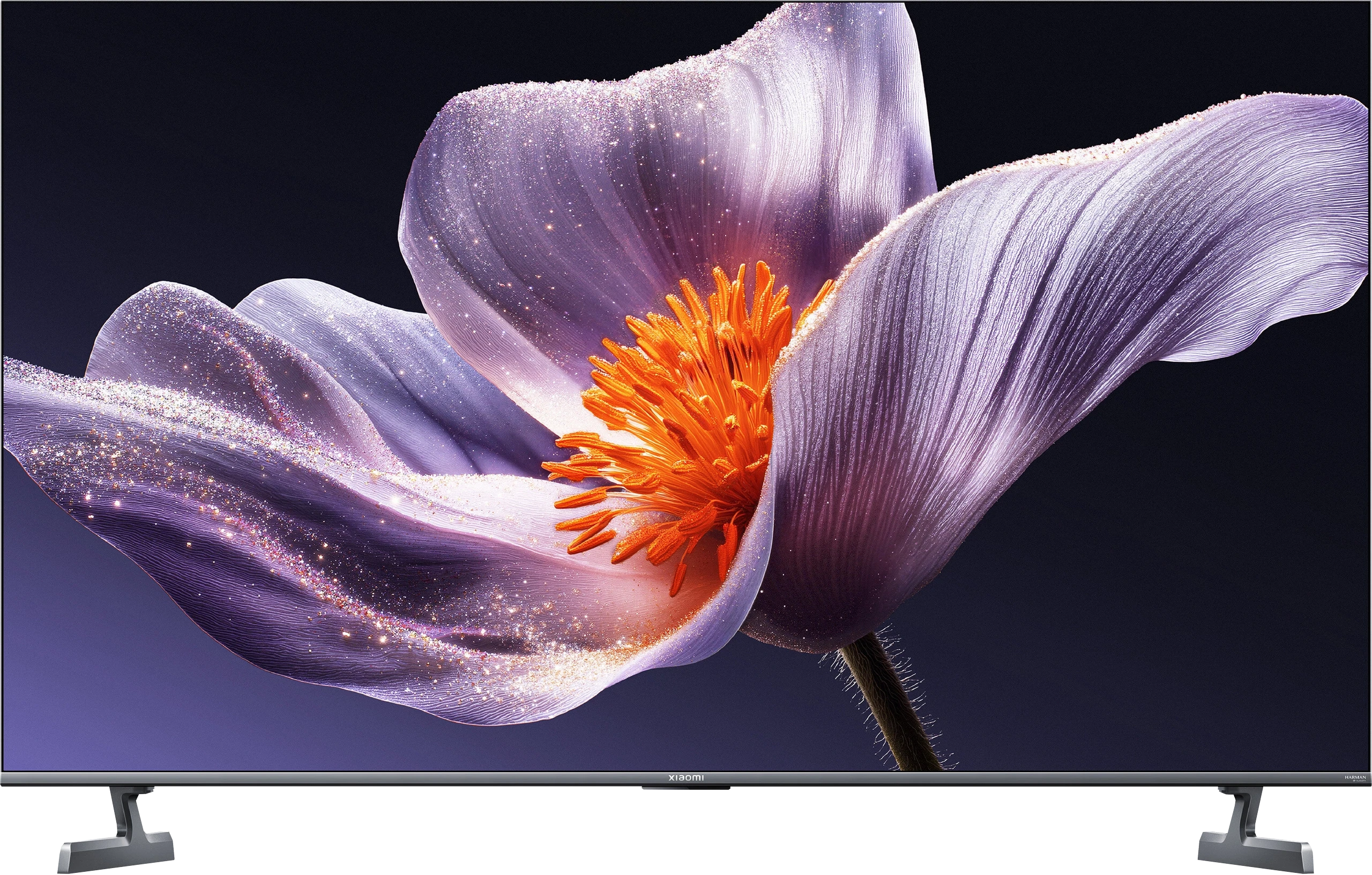
Panel type: LCD IPS
Resolution: 3840x2160
System: VIDAA
Model year: 2024
Complete the survey to find out the result

Resolution: 3840x2160
System: Google TV
Model year: 2025
Complete the survey to find out the result

Overall rating
7.0
7.2
Movies and series in UHD quality
6.4
6.7
Classic TV, YouTube
6.3
6.3
Sports broadcasts (TV and apps)
6.6
6.4
Gaming on console
8.0
7.7
TV as a computer monitor
7.6
8.6
Watching in bright light
6.2
7.4
Utility functions
8.9
7.2
Apps
7.7
9.6
Sound quality
7.0
7.1
Complete the survey to find out what fits your preferences
Advantages
Wide viewing angles thanks to the IPS matrix
Good colour potential after calibration
High refresh rate (144 Hz), VRR, ALLM, and G-Sync for gamers
Support for Dolby Vision
A good number of additional features (recording, AirPlay, mirroring)
Support for key audio formats (Dolby Atmos, DTS:X)
Relatively low input lag
Good black and contrast (SDR)
Very high peak brightness (great for a bright lounge)
Complete package for gamers (144 Hz panel, HDMI 2.1, VRR)
Extremely low input lag in SDR mode (below 10 ms)
Surprisingly good, strong sound (branded by Harman Kardon)
Support for Dolby Atmos and DTS:X
Rich Google TV system (with AirPlay and Chromecast)
Proper compatibility with PC (clear fonts and 288Hz mode)
Excellent price-to-specification ratio
Disadvantages
Average contrast and black levels
Issues with subtitle playback from USB
Missing HGIG support
In some scenes, issues with HDR brightness management
Unavailability of some popular music apps (Spotify, Tidal)
Local dimming algorithms practically don't work in HDR content
Useless Dolby Vision Gaming mode (input lag approx. 100 ms)
Poorly implemented HGiG mode
Strongly visible banding (colour stepping) in dark scenes
Very weak upscaling and digital image processing
Google TV system can "lag behind"
Our verdict
Is it worth buying the Xiaomi S Pro 2026? The answer to this question is quite complicated. Let's start with what is really great about this TV. First of all, the Xiaomi S Pro 2026 has an outstanding price-to-performance ratio. It features a Mini LED panel with very high brightness, which performs excellently in a sunlit living room. Additionally, it has a fast 144 Hz (or even 288 Hz) panel and a full gaming package: two HDMI 2.1 ports, support for VRR, and impressively low input lag (below 10 ms). If you mainly watch 'regular' content and play games, this is a fantastic screen. Even the built-in 30W speakers are surprisingly good and support Dolby Atmos. Unfortunately, there is also a second, very problematic side to this model. In short: the software. We have the impression that Xiaomi has given us great 'parts', but hasn't managed to make them work together properly. The biggest issue is the HDR mode – the main reason why people buy TVs today. For unknown reasons, the TV in HDR mode (HDR10, Dolby Vision) does not manage its dimming zones well. As a result, blacks that should be deep become grey or navy blue, like in a regular LCD TV. On top of that, there are other software issues such as the terrible implementation of HGiG or the fact that the Dolby Vision mode for gamers is unusable due to immense input lag (100 ms). Additionally, the TV's capability to process image digitally is very poor. So how can we summarise this in terms of price? In its price range, the Xiaomi S Pro 2026 crushes the competition in terms of specifications. Other TVs for this money are usually basic LCD models without dimming, and often only have a 60 Hz panel. The question then is: what is more important to you? If you're simply looking for a very bright and affordable TV for watching during the day and gaming, and you're willing to calibrate it – you will be very pleased with it. However, if you're looking for a TV to enjoy impressive HDR in movies and games straight out of the box, you will be terribly disappointed with this model. In that case, in our opinion, it's better to pay a bit more for a basic OLED TV or a more refined Mini-LED model from the competition.
TV appearance






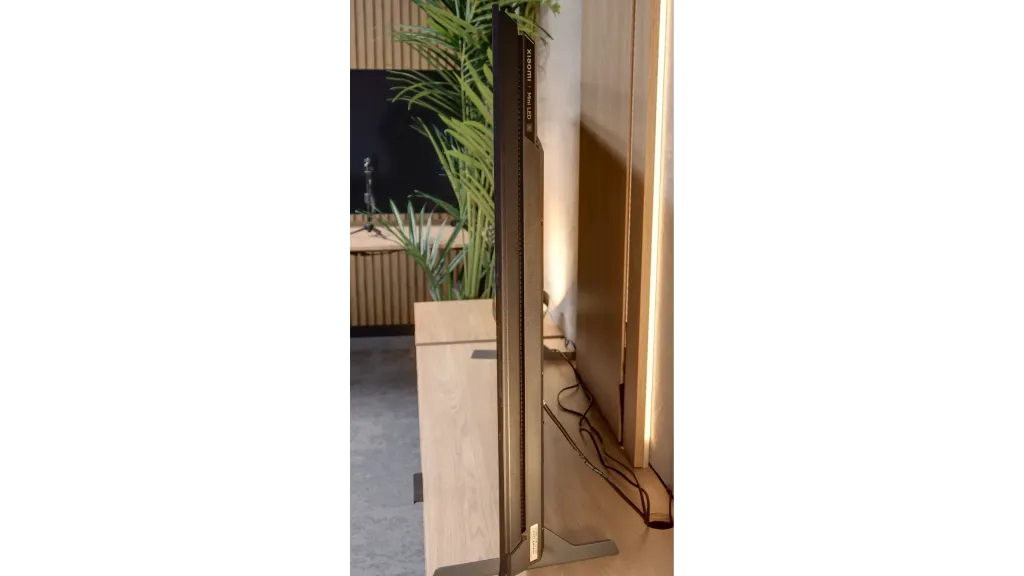

Contrast and black detail
5/10
7.4/10
Local dimming function: Yes, number of zones: 32 (4 x 8)
Local dimming function: Yes, number of zones: 532 (28 x 19)
Contrast:

Result
7,850:1

Result
4,150:1

Result
4,400:1

Result
2,500:1

Result
1,550:1

Result
1,001,650:1

Result
52,600:1

Result
17,900:1

Result
17,200:1

Result
10,150:1
Halo effect and black detail visibility:


The Hisense E7NQ PRO we've tested, in the 65-inch version, uses an IPS panel, which unfortunately isn't known for high contrast. As a result, black appears slightly "washed out" and occasionally takes on a silvery hue, which is clearly visible in our pictures. The manufacturer tried to address this by equipping the TV with local dimming functionality. Unfortunately, in this 65-inch model, we only have 32 zones available, which, while it helps a bit, is definitely not enough to achieve truly impressive results – especially since the panel itself cannot provide a cosmic depth of black.
During testing, we observed highly varied results. Under optimal conditions, it managed to reach around 7800:1, which can be considered decent; however, in more challenging scenes, the contrast dropped to around 2000:1. Such values are at best average and simply do not befit a TV in this price range. Ultimately, while local dimming somewhat salvages the situation, what’s really lacking here is true deep, inky black and contrast that would leave a greater impression on us.
Let's get to the point, which is what’s most important in the Mini LED panel: blacks and contrast. The Xiaomi S Pro 2026 is built on a VA matrix, which right off the bat promises deep blacks. On top of that, it features Mini LED backlighting with a very large number of local dimming zones. In the 65-inch variant we tested, we counted as many as 532. That’s a solid figure that should provide precise control over the backlighting. It should be noted that this number is proportional to size – opting for the smaller 55-inch variant will have fewer zones, while larger models will have more.
So, how does the black level perform on the S Pro 2026? The answer is complex.
Overall, it’s really not bad, and we see a clear improvement compared to the problematic model from 2025. As you can see on our measurement charts, the results are occasionally spectacular. In the majority of the film scenes we measured in SDR (standard dynamic range), the contrast could easily be called very good and even comparable to constructions three times more expensive. Well, it could be... and this brings us to the paradox of this model. The problem is how the television manages zones in scenarios other than SDR. As soon as we feed the TV a higher-quality signal, such as an HDR series or Dolby Vision from streaming platforms (Netflix, HBO Max, or Disney+), something strange happens. We have an irresistible impression that the TV suddenly... forgets it was equipped with local dimming zones at all. As shown in our video below, black levels in such scenes resemble more dark gray or navy shades. To this is added a slight flickering of the entire screen. This is a level we would expect from televisions completely lacking local dimming systems. It seems that Xiaomi, over the course of a year, chose to fix one key issue from last year’s 2025 model. And they succeeded – there’s no more annoying “zone disco”, the image is stable. It’s just a shame that when consuming high-quality content (HDR), this entire advanced system becomes completely useless.
HDR effect quality
5.1/10
6.3/10
Luminance measurements in HDR:

Result
408 nit

Result
299 nit

Result
446 nit

Result
215 nit

Result
527 nit

Result
809 nit

Result
526 nit

Result
1033 nit

Result
469 nit

Result
718 nit
Scene from the movie “Pan” (about 2800 nits)


Scene from the movie “Billy Lynn” (about 1100 nits)


Static HDR10


Dynamic: Dolby Vision
Dynamic: Dolby Vision


HDR luminance chart:
Xiaomi S Pro 2026
HDR luminance
Hisense E7NQ PRO
HDR luminance
Based on the luminance chart, which indicates around 550 nits, it can be considered that Hisense E7NQ PRO theoretically has the potential to somewhat "enchant" us with its HDR image. Testing various scenes from movies, we noticed that the television continually tries to balance between maintaining appropriate brightness and preserving the deepest blacks. In favourable conditions – such as in a scene from “The Meg”, where the screen is flooded with bright light – this brightness can indeed impress us. At such moments, we feel that HDR actually adds that "something" to the image. Unfortunately, when difficult shots with fine, bright elements on a dark background appear on the screen, the situation looks much worse. Brightness then drops to 200-300 nits, which is definitely too little to really distinguish HDR from standard SDR.
It is clear that the television is trying, but the hardware limitations – mainly the small number of local dimming zones – prevent it from fully spreading its wings. The end result can therefore be quite inconsistent and as average as the contrast tests. On the plus side, it deserves credit for its impressive coverage of the DCI-P3 colour gamut at 97%. This allows the television to present a truly wide range of colours, which, in the right scenes, can give us at least a glimpse of the real HDR effect. It’s just a shame that the whole picture isn't complemented by better control of brightness and contrast.
When it comes to HDR quality, the Xiaomi S Pro 2026 is undoubtedly a very bright television. On our synthetic measurement patterns, we were able to achieve peak brightness of around 1400 nits. This result is not only very good but quite spectacular, considering the price of this model. However, as we always say, our editorial team values measurements and the viewing experience of content that people watch on a daily basis – from movies to series. So let’s analyse how Xiaomi performs with film material. The result is, unfortunately, quite mixed. When very bright scenes appear on screen, the S Pro 2026 truly shows its full capabilities and can achieve a real 800-1000 nits on bright elements. Moreover, even smaller objects can "burn" the eyes – in scenes from the movie Sicario 2, small metallic parts of the helicopter were really vivid. The problem is – and here the story comes full circle, returning to our contrast assessment – that in such scenes, we can’t count on absolutely cinematic black. In our opinion, this compromise is too significant; the high visibility of details in bright sections should not come at the expense of such a substantial drop in blacks. And even though the HDR effect can create a stunning impression here, it’s important to remember that when very challenging, mixed scenes appear on screen, we may feel a slight disappointment. Precisely the one we mentioned in the previous paragraph regarding issues with dimming in HDR mode. As a consolation, it’s worth adding that the S Pro 2026 is equipped with an additional PFS filter (similar in function to a QLED layer), which effectively broadens the colour gamut coverage. As a result, measurements showed DCI-P3 coverage reaching 94%. This gives us confidence that in most colourful scenes, the image will look rich and properly saturated.
Factory color reproduction
5/10
4.1/10


Factory Mode
After calibration


Factory Mode
After calibration
When we took our copy of Hisense E7NQ PRO out of the box, we immediately started checking the available picture modes. Among them, the Filmmaker mode seemed the most promising, although it wasn't without its flaws. With standard SDR content, we noticed a clear tendency to overemphasise red, making the picture appear unnaturally warm. This was particularly evident in the comparison photo attached below. Conversely, when we switched to HDR content, the situation took a turn in the opposite direction. This time, blue was dominant, and there was hardly any red, resulting in a cool, at times almost "store-like" appearance — although not as drastic as in modes specifically designed for showcasing in displays. As a result, in our tests assessing colour reproduction, these disturbances in colour balance led to significant errors.
Additionally, the television had trouble reproducing brightness characteristics. At lower resolutions, it clearly brightened the darkest elements of the image, and with HDR content, the brightness curve (eotf) simply wouldn't align as it should. Initially, the television excessively darkened the smallest details, only to then over-brighten larger areas. Fortunately, the E7NQ PRO provides us with a lot of calibration tools, so knowing there was potential within it, we decided to take matters into our own hands and try to set it up to eliminate these issues.
Of course, all our measurements were conducted in "Film" mode, which is typically the best and most faithful choice we get straight after taking the TV out of the box. And to put it bluntly: while this is the best mode, it is still very far from perfect. Above all, the TV has a clear tendency to give the picture a cool, blueish tint – this is due to poorly set colour balance. Additionally, there is the issue of how the S Pro 2026 manages its brightness straight out of the box, which results in an over-saturated image. These two flaws contribute to really significant colourimetric errors (Delta E). In HDR content, they could double exceed our expected error scale of "10" (i.e. reaching values close to 20). Just to remind you – the threshold of perceivable error by the human eye is a Delta E value of around 3. Results at the level of 20 mean that the image significantly deviates from what the director intended.
Color reproduction after calibration
7.1/10
7.2/10




Thanks to the tools available in E7NQ PRO, we've managed to squeeze a pretty decent image out of it, especially with lower quality content. After fine-tuning the white balance of the SDR materials, the colours look much more natural, and what we see on the screen seems closer to the vision the producer intended to present. Additionally, we've improved the brightness characteristics (Gamma), so the TV no longer tends to over-brighten, and everything looks noticeably better than before our intervention.
With HDR materials, we also achieved some improvements, although it's not as rosy here. Yes, the white balance has approached an acceptable level, but the problem lies elsewhere. It's about the EOTF curve, which is how the TV manages brightness and tonality of the image. At first glance, one might think that the biggest issue concerns only the mid-tones, which are overly brightened. However, after more detailed testing and activating the EOTF curve visualisation filters, it becomes clear that the receiver has a tendency to brighten the entire screen. This seems to be a limitation due to the small number of local dimming zones and generally modest brightness management capabilities. Such hardware limitations are simply insurmountable. Nonetheless, after our calibration, the image is noticeably better than at the start. One just needs to be aware that in terms of contrast and brightness management, this model has its limits, which even a good calibration cannot fully overcome.
So how does the S Pro 2026 perform after our calibration process? We must admit that after calibration, the TV becomes a really enjoyable device for watching everyday content. As you can see in the charts, in HD (SDR) material, both white balance and gamma values have been brought to nearly perfection. Most importantly, colourimetric errors have become practically invisible to the human eye. In this scenario, the S Pro 2026 is simply a great TV that, after professional calibration, can provide a lot of joy from viewing. However, it is worth noting clearly – our efforts did little to help in 4K HDR mode. Despite the calibration, the TV still interprets the image quite strongly in its "own way," which is clearly evident in the measurement of the EOTF curve (brightness tracking). It's a bit of a shame because it shows that the problem lies not with the panel itself, but with the software. Poorly refined image management algorithms in HDR content can, unfortunately, rule this TV out for many more discerning users.
Smoothness of tonal transitions
9.2/10
6.9/10












We must honestly admit that the fluidity of tonal transitions in this TV is right at the top of what we've had the opportunity to test in 2024. Even in really demanding scenes, we hardly notice any noticeable "steps" between colours. Yes, with a keen eye, one might spot some minor flaws, but that's at a level that's almost microscopic. You really need to have a very "alert" eye to catch them. This, in turn, means that when watching even the most complex shots in a full spectrum of colours, you can simply focus on the story and visual impressions without the annoying, artificial effect of posterization.
Now, let’s move on to the analysis of tonal transitions, which refers to the fluidity with which the television can render transitions between closely related shades. In the case of the Xiaomi S Pro 2026, the image that emerges is extremely dualistic. On one hand, we have bright gradations. When scenes with a blue sky or other smooth transitions appear in the bright parts of the image, the S Pro 2026 handles them excellently. They look perfectly smooth, without any visible artifacts.
Unfortunately, the situation changes dramatically as soon as dark scenes take over the screen. To put it bluntly – they look really poor. Instead of a smooth tonal transition in the darkness, the screen clearly shows colour banding and unsightly "stepping" of gradients. This is very noticeable in darker films or games and can effectively ruin the viewing experience.
Image scaling and smoothness of tonal transitions
6/10
4.5/10
Smooth transition function

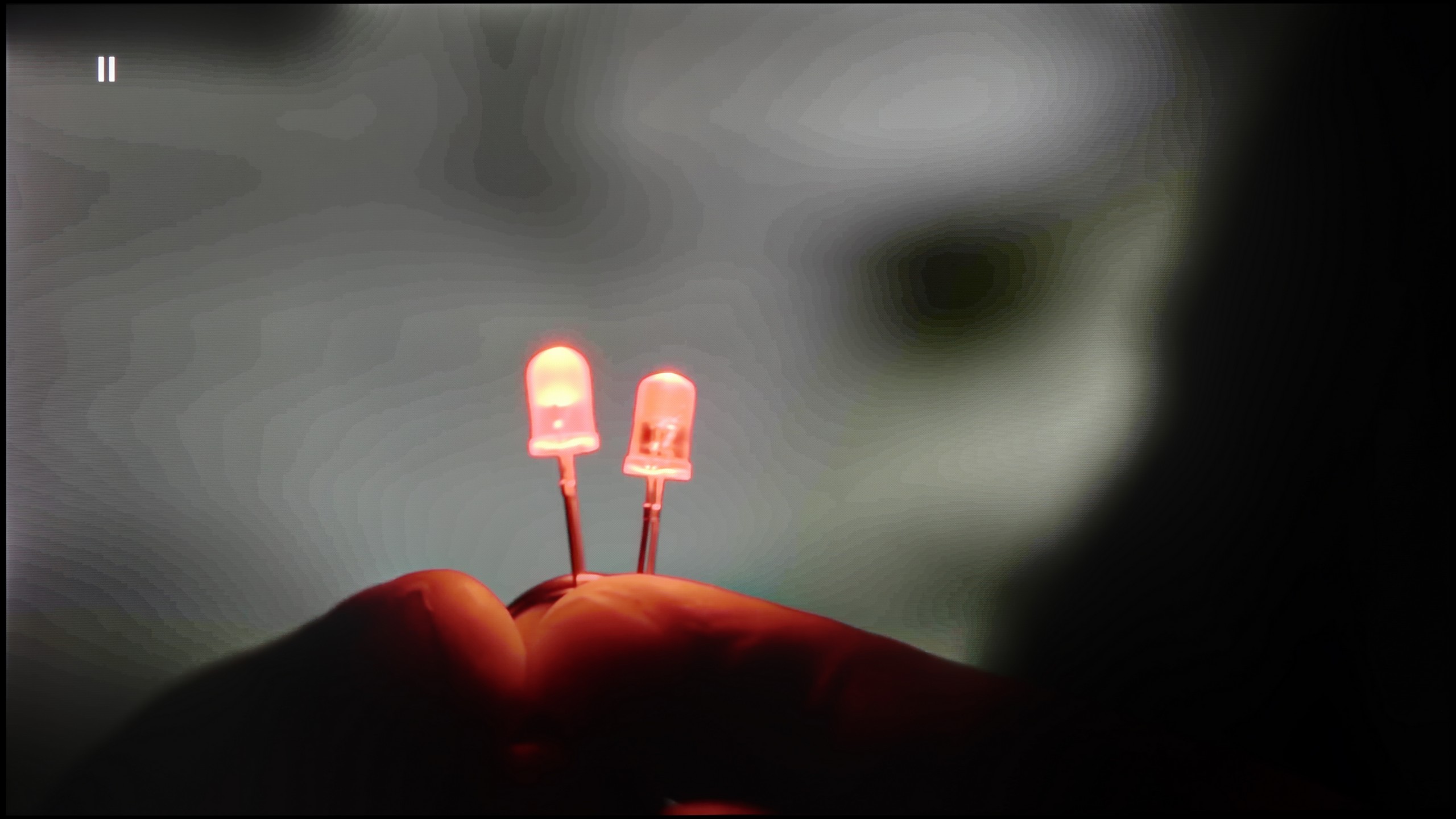
Image without overscan on the SD signal


When it comes to the tonal transition smoothing function in lower quality materials, the “smooth and gradient image” feature in Hisense E7NQ PRO unfortunately does not impress. At the lowest setting, the change is barely noticeable – it's more of a cosmetic improvement. Switching to “Medium” mode does produce a noticeable effect, but it's still nothing special, and the TV starts to excessively interfere with other elements of the image, which can look unnatural.
Image scaling is also rather average. On the test screen, where a portrait of a model and text are displayed, there are slight frays at the edges, making the overall presentation less smooth and aesthetic than we would expect in this class of device. It's just hard to talk about really effective improvement of lower resolution quality here.
Let's start with the issue we raised in the previous paragraph: can a TV even fix the problem of terrible tonal transitions in dark scenes? Theoretically yes – in the menu, we find a feature with the promising name "Colour Contour Removal." Well, "theoretically." Unfortunately, in practice, this setting – regardless of which of the three power levels is chosen – yielded absolutely no real results. So we are dealing with a feature that practically only exists in the menu. Moving on to the quality of upscaling (scaling from a lower resolution to 4K), unfortunately, we have more bad news for you. The S Pro 2026 handles this task very poorly. Interestingly, the phenomenon of "overscan" (slight image cropping) is not a major issue here. The problem is that the TV simply shows a very raw, unprocessed image. Its attempt to boost the signal to a higher resolution looks simply dull and lacks any "intelligent" enhancement. There's no denying it – the entire digital image processing is the true Achilles' heel of this model.
Blur and motion smoothness
7/10
7.5/10

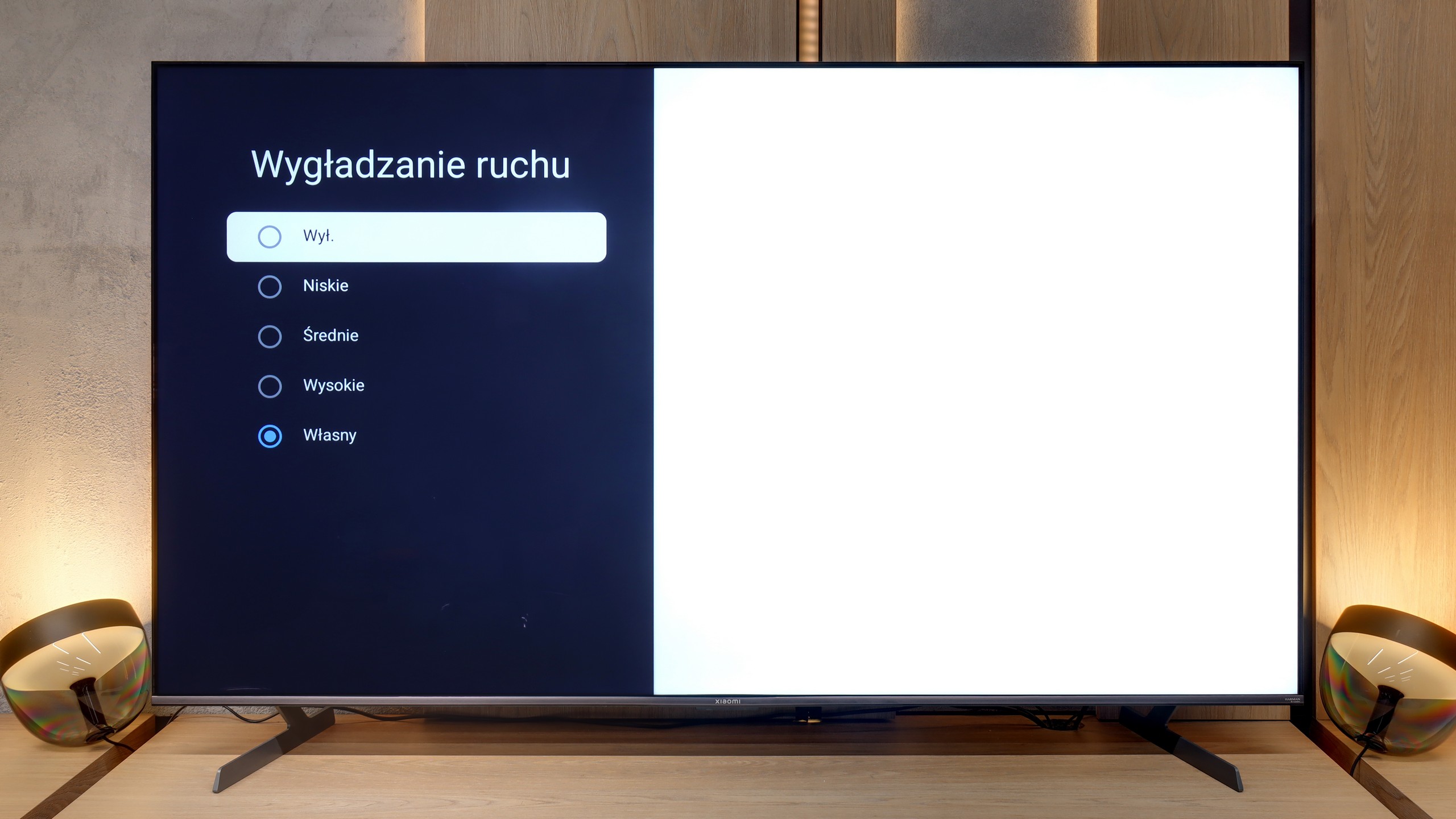
Blur (native resolution, maximum refresh rate):






Smużenie ():
Smużenie (1080p@288Hz):



Thanks to the use of a 144 Hz panel, E7NQ PRO performs exceptionally well with almost any type of content. Whether we're watching fast-paced matches, dynamic games or action films – the fluidity of motion leaves a good impression. When it comes to movies, the manufacturer has equipped the TV with two key tools: “motion blur reduction” and “judder reduction.” Each of these functions can be adjusted on a scale from 1 to 10.
At lower values, the processing is subtle, barely noticeable, and gently smooths motion without ruining the cinematic character of the image. The higher we move up the scale, the more clearly the TV interferes with the presented material, smoothing motion more aggressively, thereby minimising any judders or micro-cuts. Conversely, the highest settings can resemble the so-called “soap opera effect,” which makes the image look overly smooth, slightly losing its cinematic atmosphere. Thanks to this scale, however, we can find a happy medium, adjusting motion fluidity to our own preferences.
On paper, the specifications of the S Pro 2026 look impressive. The television is equipped with a native 144 Hz panel, capable of displaying images at up to 288 Hz in a dedicated gaming mode. These are incredible results, but what we were most interested in, in the context of everyday use, was how the TV handles motion blur and how the picture looks at 120 Hz. After all, this is the frequency used today by consoles such as the PlayStation 5, Xbox Series X/S, and it is desirable for sports fans. Generally, the panel "holds up". The matrix is quick enough to meet these challenges, and objects displayed at a native smoothness of 120 Hz are rendered correctly. When it comes to software, the TV is equipped with motion smoothing technology, but with a key caveat – it only works for input signals up to 60 Hz. This means it's mainly suitable for traditional TV, movies, and series. With it, we can adjust the smoothness of the picture to our own preferences – ranging from a very smooth, "theatrical" approach, to setting the slider at "zero" and maintaining a fully cinematic character.
Console compatibility and gaming features
8.5/10
8.2/10
- ALLM
- VRR
- VRR range48 - 144Hz48 - 144Hz
- Dolby Vision Game Mode
Yes, high input lag
- Correct implementation of HGIG
- 1080p@120Hz
- 1440p@120Hz
- 4K@120Hz
- Game bar

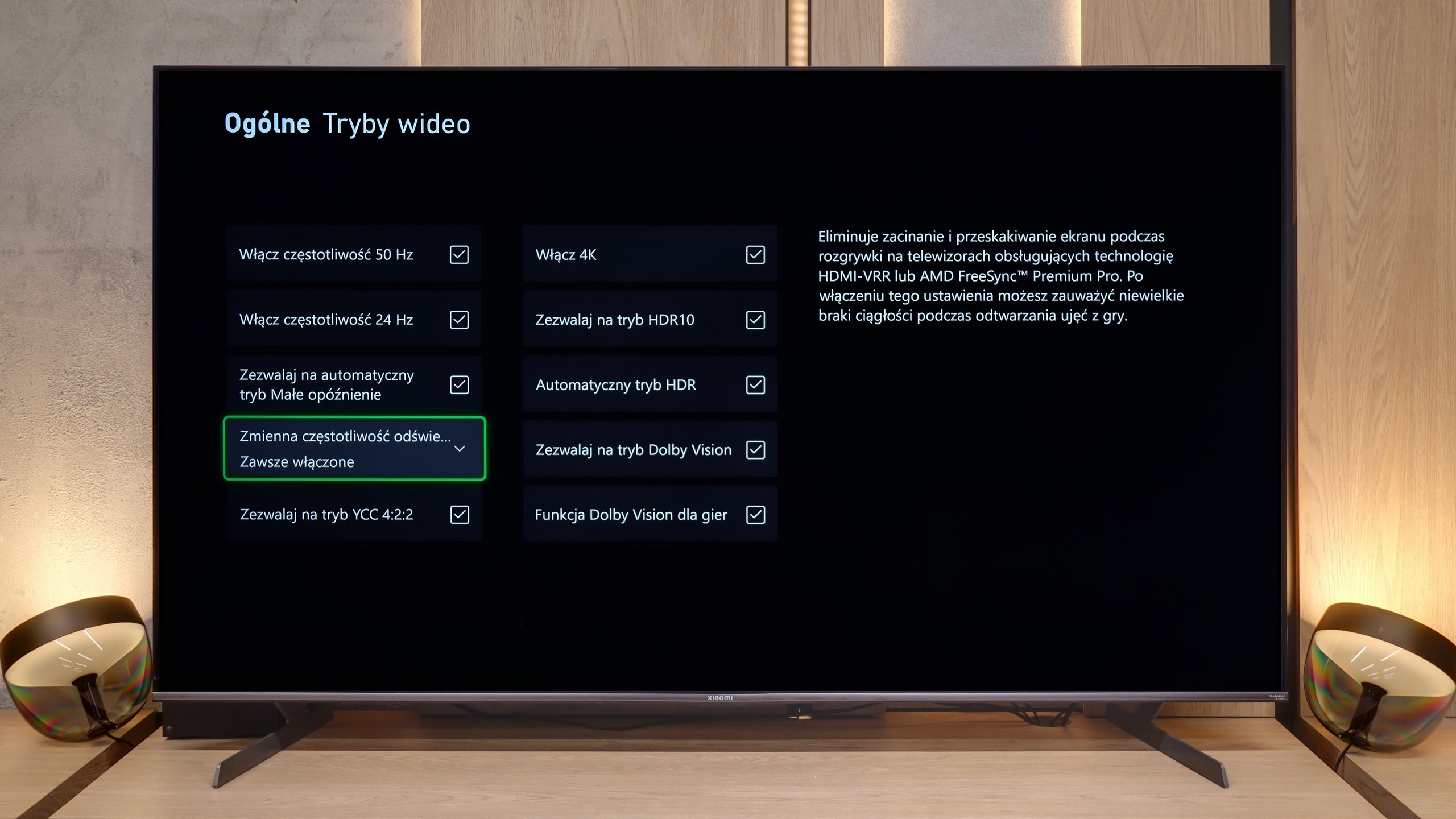

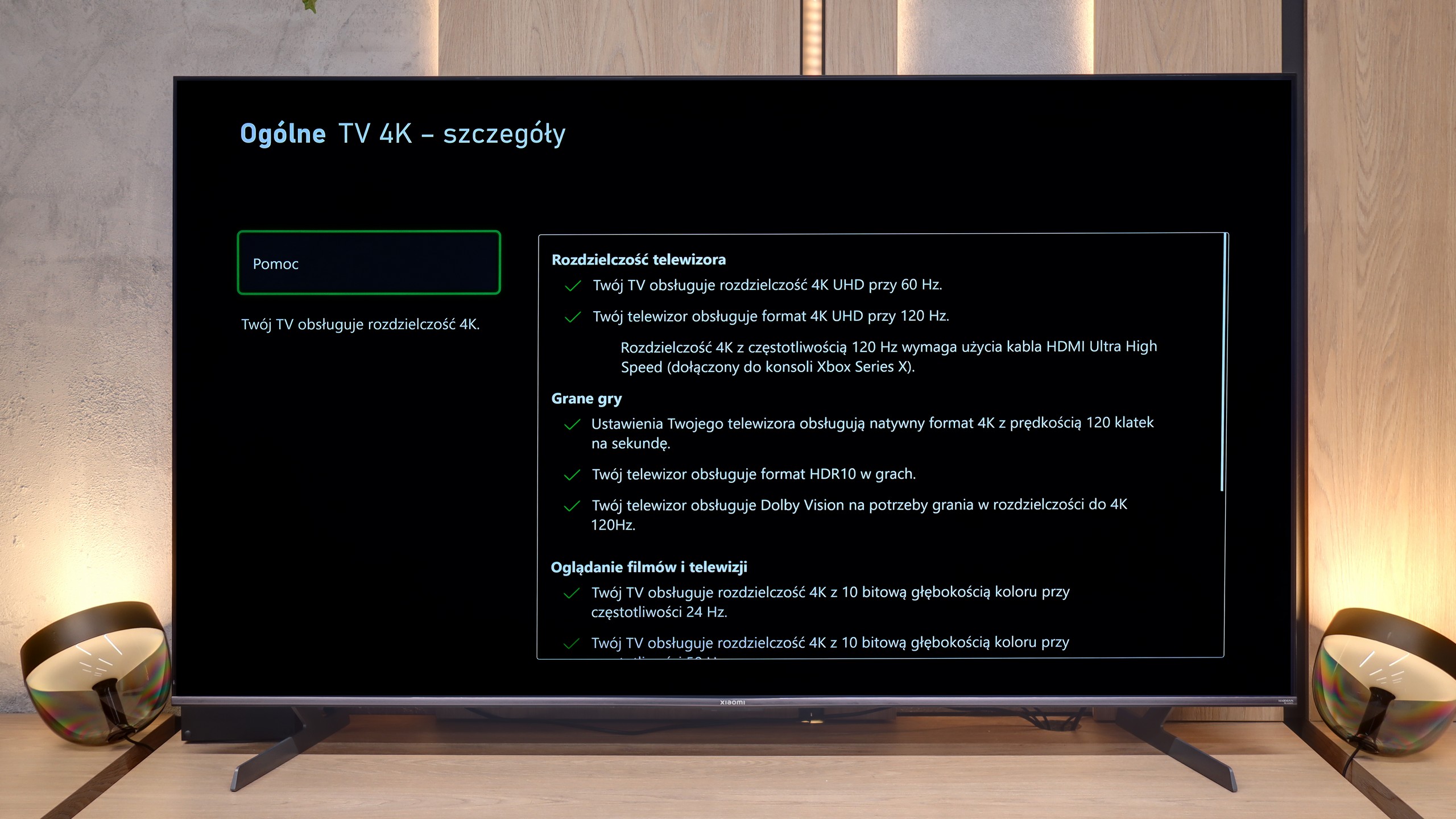



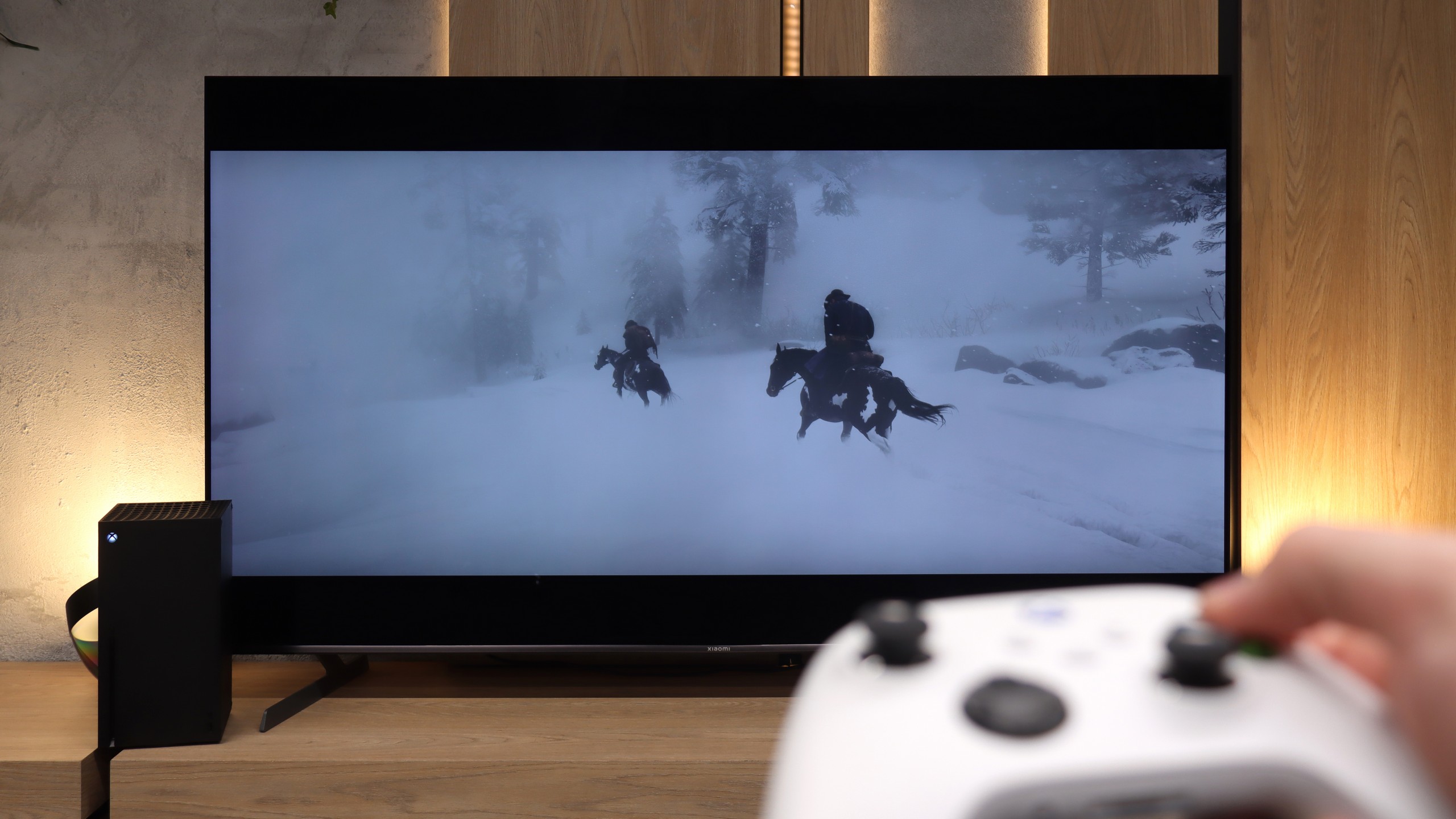
If we sometimes like to turn on the console and immerse ourselves in the world of games for long hours, E7NQ PRO can make a really good impression. Thanks to the 144 Hz refresh rate, the gameplay is surprisingly smooth, and support for HDMI 2.1 and VRR ensures that the image doesn't "tear" even during the most dynamic actions. Additionally, there's ALLM, which automatically sets the lowest latency as soon as we switch to the console – so we don’t have to fiddle around in the options ourselves.
A big plus is also the ability to launch games in Dolby Vision, which makes colors and contrast simply look better. Hisense has also included a clear "gamebar," allowing us to continuously monitor the key parameters and change settings without leaving the game. The only thing we might slightly regret is the lack of HGIG support. It may not be a crucial element, but for some gamers, it can matter if they aim for the most faithful reproduction of the creators' vision. Nevertheless, in practice, the E7NQ PRO performs excellently and delivers truly enjoyable gaming experiences.
For gamers, the Xiaomi S Pro 2026 is on paper an almost perfect proposition. It has been equipped with two HDMI 2.1 ports, which allow us to unlock (although these options are somewhat hidden in the menu) the full suite of features: ALLM, VRR, and, crucially, the ability to operate in 4K at 144 Hz. This last feature should particularly please owners of powerful PCs. The TV also has something resembling a gamer panel – and while it’s hard to call it a full-fledged "Gamebar," it does its job by displaying key information. It’s just a shame that in its default form, it covers a relatively large part of the screen.
The biggest problem we have with this model, however, concerns how the S Pro 2026 handles games in HDR mode. To put it bluntly: it doesn’t handle it well. Due to the poorly implemented HGiG feature (the HDR tone mapping standard for games), during the initial HDR calibration on the console, it’s very easy to "blow out" the image. If someone is unaware of this software flaw and follows the on-screen instructions, they will simply set the picture incorrectly, with burnt-out details in bright areas. Another significant issue is the Dolby Vision mode for games. While it works, it generates such a high input lag that it becomes noticeable in dynamic titles. (You can check all our lag measurements in the paragraph below). In summary: Generally, this is a really very good screen for gamers, but with one small caveat. We would rather avoid HDR mode on it – unless we decide to manually set the brightness slider on the console "by eye," completely ignoring the tips from the console's pictogram.
Input lag
9.9/10
8.5/10
SDR
HDR
Dolby Vision
In this regard, Hisense E7NQ PRO really performs well. At a frequency of 60 Hz, we recorded around 15 ms, and at 120 Hz, the input lag drops to as low as 6 ms, allowing for very quick reactions and smooth controls in games. It's also worth mentioning that even in Dolby Vision mode, the input lag doesn't drastically increase. This means we can enjoy better image quality without sacrificing responsiveness, which will definitely please any avid gamer.
We’re moving on to one of the most important measurements for gamers, which is signal delay (input lag). Overall, the Xiaomi S Pro 2026 performs excellently here. Generally, in game mode, the lag is very low. With 120 Hz content (from consoles or PC), we easily achieved results below 10 ms. These are truly outstanding results and, in practice, absolutely unnoticeable for most people, even those who are very sensitive. Unfortunately, there is one "but," which constitutes the biggest drawback of this model for gaming. We're talking about Dolby Vision Gaming mode. When this mode is activated, the input lag rises to an astronomical level of about 100 ms. At such a value, the delay between our movements on the controller (we tested on an Xbox console) and what is displayed on the screen becomes really very large and annoying. Therefore, our recommendation is simple: we absolutely do not recommend using Dolby Vision Gaming mode on this television.
Compatibility with PC
7.6/10
8.6/10

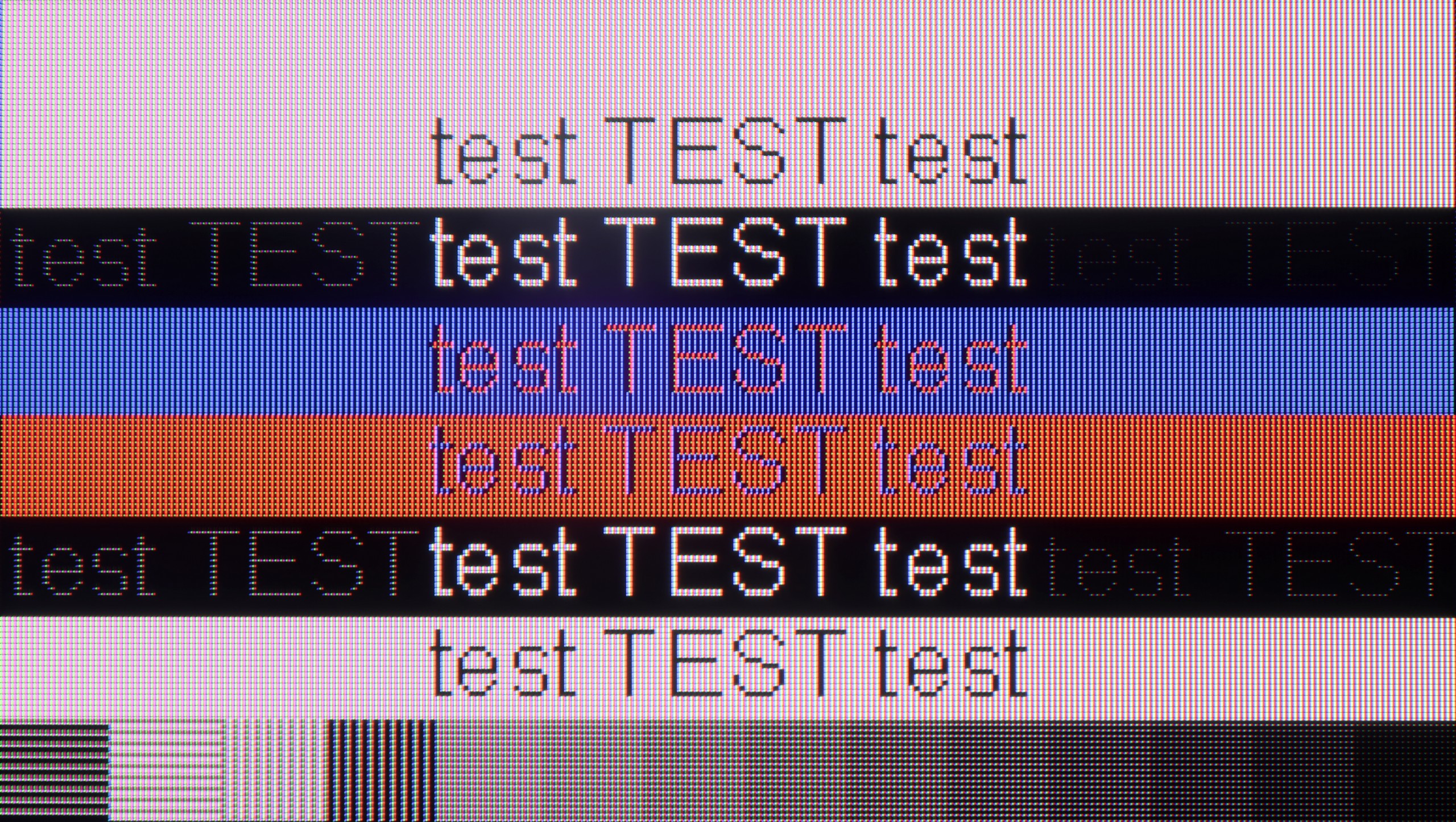
Connecting E7NQ PRO to a computer will give us no reasons to complain. Overall readability of fonts is quite good, although with very thin horizontal lines (the so-called "roofs" of letters), we noticed a slight dimming. It’s not a big issue, but worth mentioning if we plan to spend long hours in text editors or browsing the web.
On the other hand, when it comes to gaming on PC, the TV shows its true colours. Support for G-Sync, connection to a 144 Hz panel, and low input lag ensure that even the most demanding titles run smoothly and responsively. As a result, we have a screen that works well not only with a console but also as a solid "window" into the world of PC entertainment.
Generally, when it comes to gaming, the S Pro 2026 is a great screen for PC owners. It offers a refresh rate of up to 288 Hz at Full HD resolution or a full 144 Hz at 4K. All of this, supported by technologies like AMD FreeSync and G-Sync, really means a lot for very demanding gamers. And what about "desktop" work? Here we have good news. Although the displayed font may not be perfectly sharp (like on a dedicated PC monitor with an IPS panel), it is presented in a really pleasant and readable way. This is due to the correct implementation of Chroma 4:4:4 sampling, which ensures that the text is clear and there are no issues with colour fringing.
Viewing angles
6.5/10
3.7/10
In the case of Hisense E7NQ PRO, viewing angles are definitely a strong point, thanks to the IPS panel. This means that when we look at the screen even from a significant angle, the colours and brightness do not "drop off" as much as they do in TVs with VA panels. Of course, compared to OLED or QD-OLED screens, where the image remains virtually unchanged from any side, IPS still comes up short. Nevertheless, among LCD TVs, it is difficult to find a solution that guarantees such good viewing angles as those offered by IPS. Unfortunately, everything has its price – in this case, one must come to terms with average black levels and lower contrast.
As for a TV equipped with a VA panel, we must admit that the drop in brightness when deviating from the screen's axis is relatively minor on the Xiaomi S Pro 2026. However, it is important to remember the second, crucial aspect – colour saturation degrades significantly at an angle. This is typical behaviour for TVs with VA panels that lack additional coatings to widen viewing angles. Is this a disadvantage of this TV? Not really. It's simply a characteristic, the price we have to pay for the key benefits of a VA panel in terms of its high native contrast.
Daytime performance
6.2/10
7.4/10

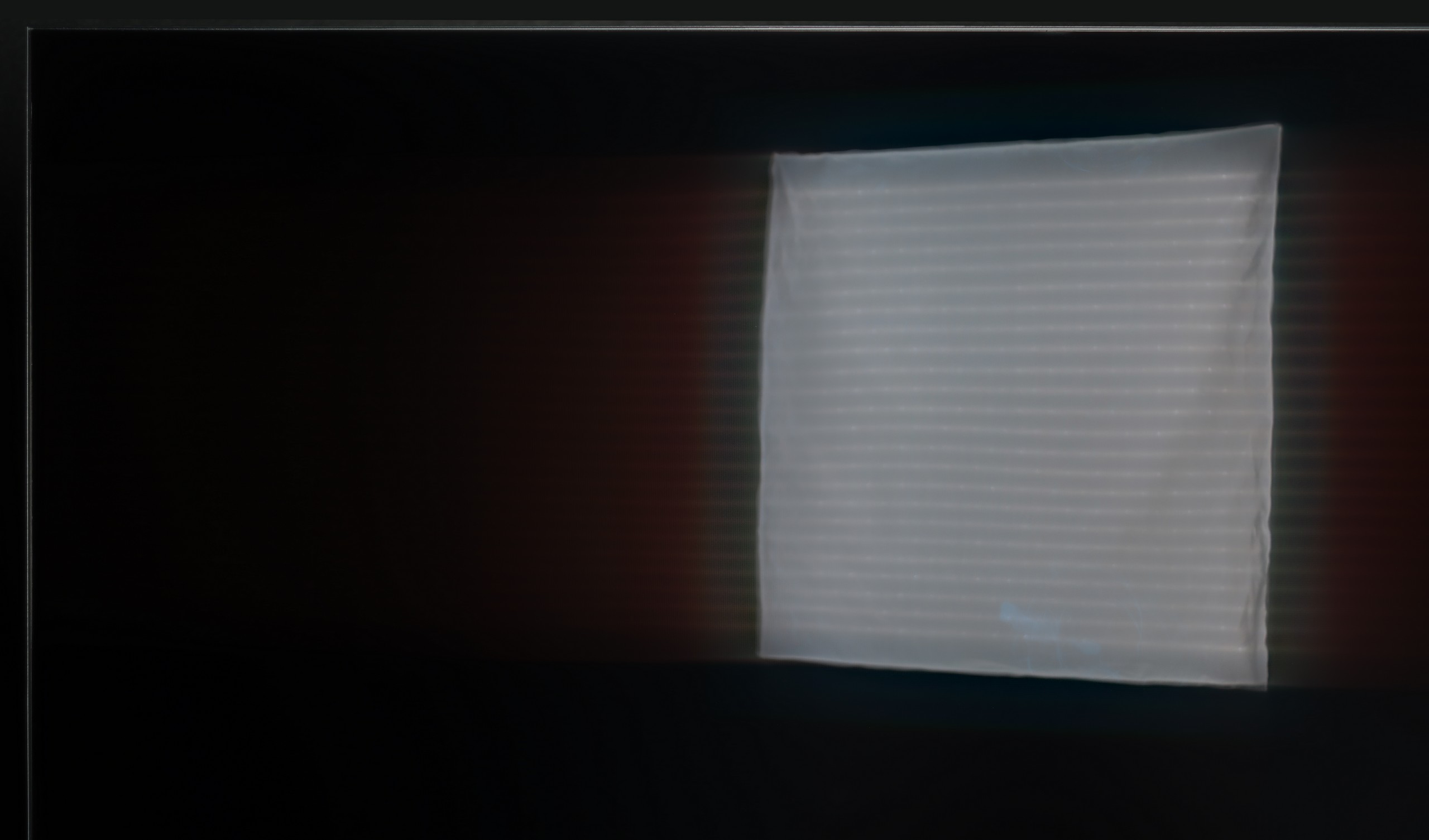


Panel brightness
Average luminance SDR
Xiaomi S Pro 2026: 771 cd/m2
Hisense E7NQ PRO: 478 cd/m2
On a bright day, E7NQ PRO performs quite well. The "satin" panel diffuses light effectively, so reflections and glare don't turn into distracting "spots" on the screen. With average brightness at around 500 cd/m², you can comfortably watch television in a sunlit room without much struggle to see details or clear content. It may not reach the level of the top premium models, but in everyday use, it still performs pretty decently.
Due to its extremely high peak brightness, the Xiaomi S Pro 2026 performs really well in bright, sunlit rooms. In most scenarios, it's able to "break through" even very strong lighting in the room. However, it's worth noting that the matrix used here does a fairly average job of suppressing reflections. This means that in darker areas of the image, or when the TV is displaying a dark scene, direct reflections (e.g., window or lamp reflections) can be irritating. Nevertheless, the S Pro 2026, as a TV for a bright living room, excels really well thanks to its powerful brightness.
Panel details
Subpixel Structure:

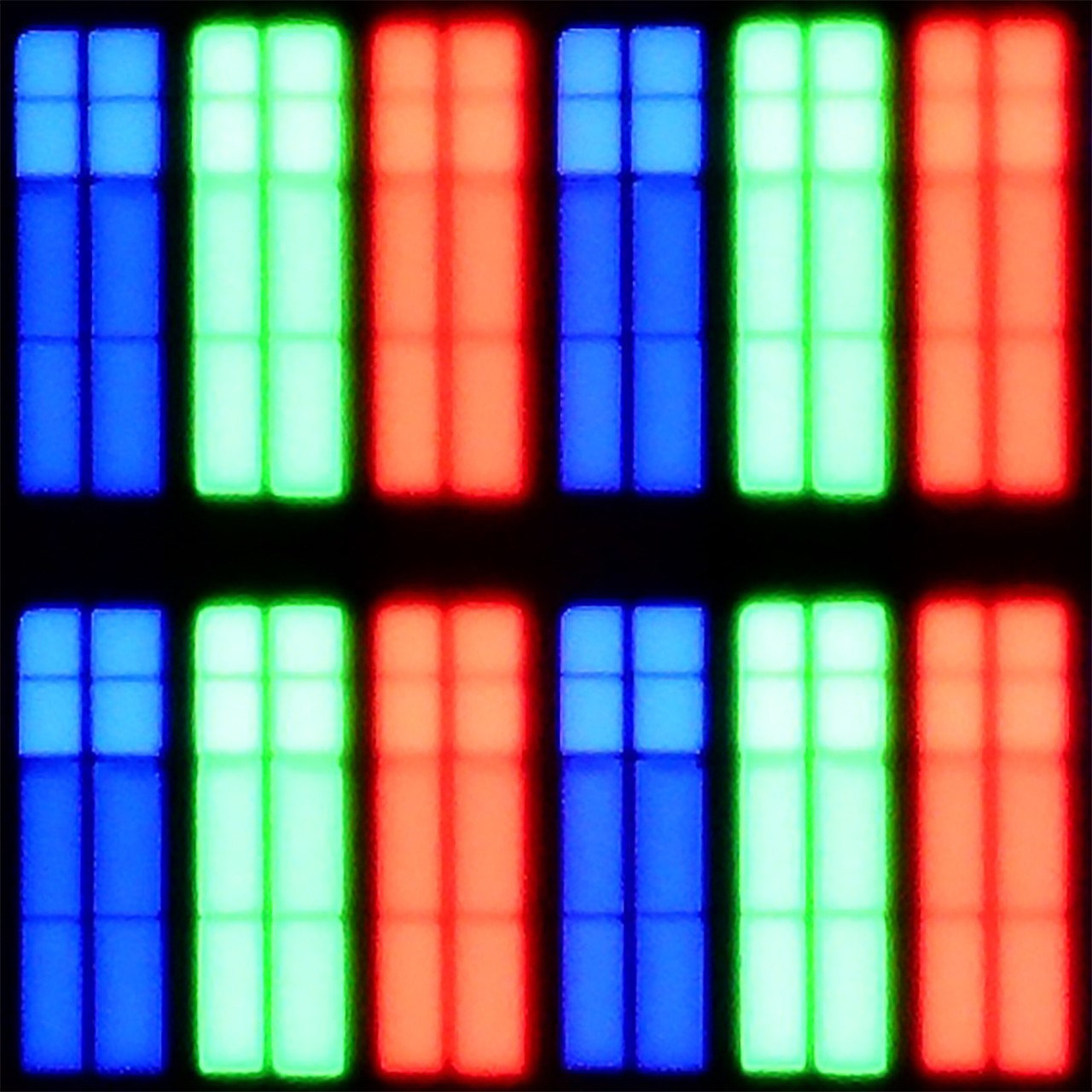
Panel uniformity and thermal imaging:


Hisense E7NQ PRO
Xiaomi S Pro 2026
TV features
8.9/10
7.2/10
- HDMI inputs2 x HDMI 2.0, 2 x HDMI 2.1 48Gbps1 x HDMI 2.0, 2 x HDMI 2.1 48Gbps
- Other inputsRCA (Chinch)
- OutputsToslink (Optical audio), eARC (HDMI), ARC (HDMI), Mini-Jack (Headphones)Toslink (Optical audio), eARC (HDMI), ARC (HDMI), Mini-Jack (Headphones)
- Network InterfacesWi-Fi 2.4GHz, Wi-Fi 5GHz, Ethernet (LAN) 100MbpsWi-Fi 2.4GHz, Wi-Fi 5GHz, Ethernet (LAN) 100Mbps
- TV receptionDVB-T, DVB-T2, DVB-S, DVB-S2, DVB-CDVB-T, DVB-T2, DVB-S, DVB-S2, DVB-C
Classic features:
- Recording to USB (terrestrial TV)
- Recording programming
- Picture in Picture (PiP)
- RF remote control (no need to aim at the screen)
- Backlit remote control
- Teletext
- Audio only mode
- Bluetooth headphones support
- Simultaneous Bluetooth headphones & TV audio
Smart features:
- AirPlay
- Screen mirroring (Windows Miracast)
- Voice search
- Voice search in native language
- Ability to connect a keyboard and mouse


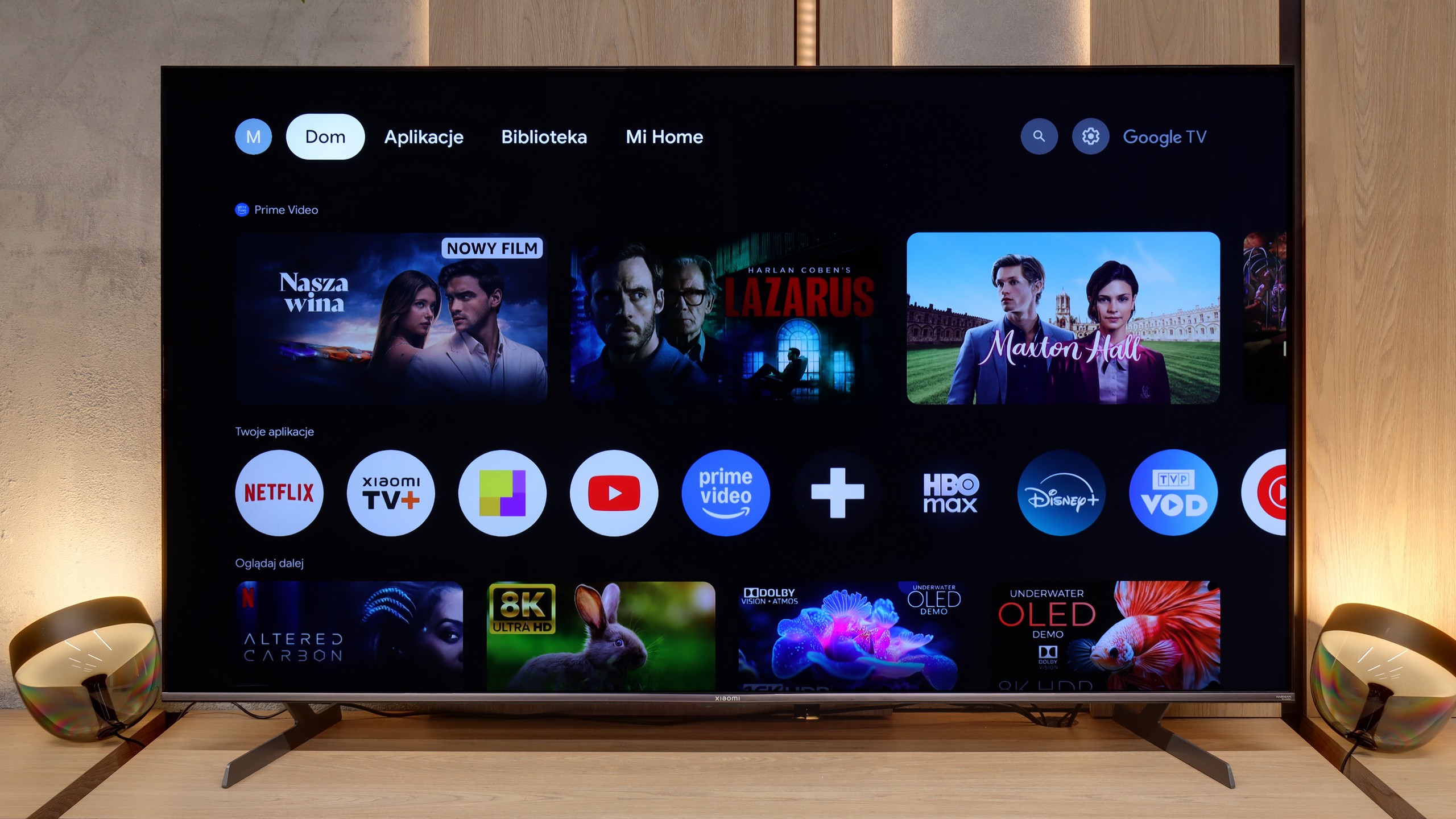
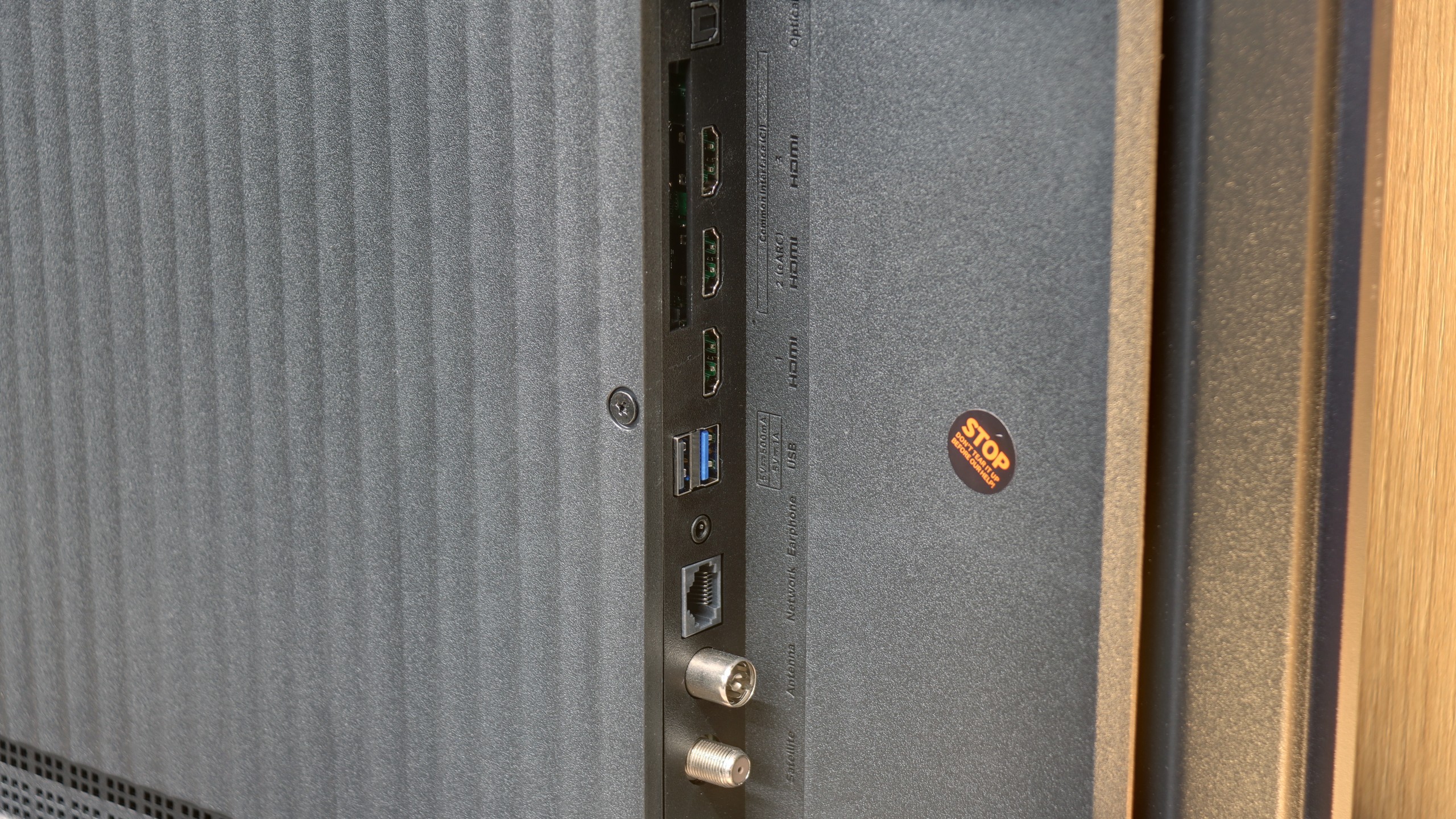

Hisense E7NQ PRO operates on the VIDAA system, which has recently made significant progress. You'll find most popular applications here, although unfortunately, some music platforms, such as Spotify and Tidal, are missing. Nevertheless, navigating the menu is quite pleasant, and the responsiveness is at a satisfactory level. Yes, there are occasionally minor 'stutters', but it's not something that will ruin our experience of everyday use.
On the plus side, we can count on support for voice search in Polish, which makes it easier to find favourite content without the tedious typing of letters one by one. The TV also offers plenty of additional options: we can record programs, use AirPlay and mirroring, and enjoy extensive wireless connectivity features (Wi-Fi and Bluetooth). It may lack a backlit remote control or Picture-in-Picture (PiP) mode, but those are relatively niche features, so not many will actually feel their absence. In everyday use, we simply have a solid base of useful tools and convenient solutions.
Operating System (Google TV)
An enormous advantage of the Xiaomi S Pro 2026 is undoubtedly the presence of the Google TV system. This gives us access to a gigantic library of apps – we can literally find everything here, from leading VOD platforms to niche players. The system also offers plenty of useful features, such as built-in Chromecast, support for AirPlay and Screen Mirroring, and efficiently functioning voice search. The Google TV system itself is great, but Xiaomi's implementation needs a little adjustment. During our tests, it occasionally experienced a proverbial "breathlessness." Animations would stutter slightly, and the response to commands was not immediate. This is certainly not the level of fluidity we know from top-tier, significantly more expensive models equipped with more powerful processors.
TV Features and Connectivity
So how does the S Pro 2026 perform as a "regular" television? Unfortunately, we have less good news here. In terms of traditional television viewing, we can mainly praise this model for having a convenient remote with a numeric keypad – which (surprisingly) is no longer a standard today. However, this is where the conveniences end. We won’t find either USB recording functionality (PVR) or PiP (Picture-in-Picture) options. On the plus side, we acknowledge the extensive Bluetooth connectivity options. We were able to connect external devices to the TV without any problems, such as wireless headphones, a keyboard, or a mouse, which significantly eases operation.
Playing files from USB
5.2/10
6.8/10
Supported photo formats:
Maximum photo resolution:


If we're counting on comfortable viewing of films with subtitles straight from a USB drive, we might unfortunately be disappointed. Just like in the previously tested A7NQ, here we encounter quite an odd situation: the TV doesn't display subtitles, even if we correctly place them on the storage device and try different formats. Paradoxically, we find options to change the colour and appearance of the font, but as they say – what's the point if we still can't see anything?
In the case of other files, such as photos or music, the E7NQ PRO manages without major issues, playing the most popular formats without a hitch. Unfortunately, for those wanting to use the TV as a multimedia player, the lack of functioning subtitles is a significant inconvenience.
The built-in, default media player in the Xiaomi S Pro 2026 is – considering the capabilities of the Google TV system – simply poor. Its biggest disadvantage is that it does not support characters beyond those from the standard alphabet. Consequently, it does not display, among other things, Polish fonts in subtitles or file names. Fortunately, as we mentioned earlier, the heart of the television is Google TV. This system allows for the quick installation of an external player, which is significantly better, such as VLC or Kodi. For this television, we recommend installing an alternative player immediately after the first startup.
Apps
7.7/10
9.6/10














































Sound
7/10
7.1/10
- Maximum volume-82dB
- Dolby Digital Plus 7.1
- Dolby True HD 7.1
- Dolby Atmos in Dolby Digital Plus (JOC)
- Dolby Atmos in Dolby True HD
- DTS:X in DTS-HD MA
- DTS-HD Master Audio
When it comes to the built-in speakers, Hisense E7NQ PRO pleasantly surprised us. Of course, it's not on the level of a decent soundbar or home cinema setup, but in everyday conditions, it performs really quite well. During our tests, the dialogue remained clear, and the sound was sufficiently clean and spacious that we didn't feel the need to immediately invest in additional audio equipment.
The support for multiple audio formats is also a plus – from Dolby Atmos to the less common DTS:X. This means that if we come across suitable source materials, we can count on a more immersive, spatial experience. Although in terms of sound, it still mainly remains at the level of a decent baseline, Hisense E7NQ PRO should satisfy most users who simply want to turn on the TV and hear clear, uninterrupted audio.
We have to admit that the S Pro 2026 really surprised us in a positive way. The television is equipped with a 30W speaker system, which, for its class, sounds really very good. There’s even a perceivable hint of bass, and the mids and highs are quite well balanced. Of course, all this is within the capabilities of the television's speakers, but it’s a level we didn't expect from such a relatively cheap model. A huge plus is also the support for top audio technologies. The television is able to decode not only the very popular Dolby Atmos format but also the recently rather rare DTS:X, which we mainly find on Blu-ray discs.
Sound Quality Test
No sound test video
Acoustic Measurements
No acoustic data
82dBC (Max)
75dBC
